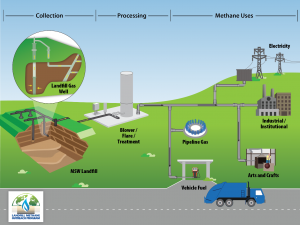 By Joe Rudek and Stefan Schwietzke
By Joe Rudek and Stefan Schwietzke
In this climate-conscious economy, where many consumers demand cleaner energy options, gas companies are exploring more opportunities to reduce their carbon footprint.
One option gaining traction is biogas – a form of natural gas that comes from decaying biological sources (like decomposing food and manure), rather than fossil fuels. In fact, gas utilities from Vermont to California have introduced programs to allow their customers to purchase biogas through the existing gas system.
Some utilities suggest that biogas cuts carbon emissions across the energy sector. However, the reality is that biogas must be developed with safeguards that protect the climate and local environmental conditions, and is only one tool among many needed to address the climate crisis.
The biogas basics
Biogas is typically about two-thirds methane (CH4) and one-third carbon dioxide (CO2). Both are climate pollutants, and while CH4 doesn’t last in the atmosphere as long as CO2 (about 10 years compared with hundreds of years) it’s far more potent – responsible for about 25% of current global warming.
Not all biogas is created equal Share on XBiogas can be processed to about 95% CH4 – what is often called biogenic CH4 or renewable natural gas (RNG). When biogenic CH4 is combusted (on a stove top burner, for instance) it still creates CO2 emissions, but since the biogas is derived from plants (which naturally remove CO2 from the atmosphere), the CO2 emissions are generally considered climate-neutral as relatively little fossil carbon is added to the atmosphere. So, there are climate benefits to capturing and using biogenic CH4 gas currently emitted from landfills, lagoons, animal-feeding operations and other existing sources. Even if this CH4 capture is imperfect, it’s beneficial because there is a net reduction in CH4 emissions. In addition, when used as a fuel, it can provide climate benefits by reducing use of fossil energy sources.
But not all biogas is carbon neutral.
The right (and wrong) way to develop biogas
The benefits of capturing and using biogenic CH4 strongly depend on where the biogas comes from and the infrastructure used to process and deliver it. For example, while some leakage in the capture of current CH4 emissions sources still reduces net pollution, if new biogenic CH4 were generated from sources not currently producing it (for example wood product wastes or purpose grown crops), subsequent leakage of that new biogenic CH4 would increase atmospheric CH4 concentrations. Given the potency of CH4, any net increase in emissions would be counterproductive. Biogas production also only generates climate benefits if it replaces fossil gas instead of adding to global production.
A 2018 peer-reviewed paper by Alvarez et al (2018) estimates that a loss rate of about 3% negates the climate benefits of replacing fossil natural gas with biogenic CH4 generated from new sources for at least a couple of decades. This underlines the importance of minimizing CH4 leakage, which is equally relevant for biogas.
Therefore, according to Alvarez et al., even the climate benefits of capturing and using existing emission sources could be overcome if higher net CH4 emissions results. One example of this would be a landfill CH4 capture system that currently flares captured biogas where subsequent diversion of the biogas for processing, pipeline distribution and use results in higher CH4 emissions relative to flaring.
A framework for biogas oversight
A 2018 paper from the World Resources Institute (WRI) proposes two key conditions to consider to ensure biogas is climate positive.
- First, biogas must be produced from waste, and not other sources of organic material. Use of waste avoids competition with food production, timber, other human needs and ecosystem carbon storage.
- Secondly, biogas must reduce net CH4 emissions to the atmosphere. As referenced earlier, net increases in emissions can occur when biogas comes from new CH4 sources (methane that would not otherwise have entered the atmosphere), or existing biogas sources whose capture systems result in higher net CH4 emissions.
Since it’s clear that biogas must be sourced responsibly to be a true climate win and avoid creating more problems than it solves, state and local agencies must be careful not to overestimate the volume of biogas available to replace fossil fuels.
A final element to consider is the management of the remaining waste products from the anaerobic digestion of animal manure. The nutrient-rich solids and effluent remaining in the digester are typically applied to nearby crops, but appropriate care must be taken to avoid impacts to water, air, and nearby communities.
Where all of these conditions are met, biogas could present a major opportunity for farms and other existing agricultural sources to reduce waste by cutting flaring and useable CH4 losses.
A clear direction forward on biogas
Replacing fossil fuels with biogenic CH4 only works for the climate if biogas is responsibly sourced and emissions are very well controlled. Otherwise, conditions could cause perverse climate impacts that undercut or even totally eliminate the value of biogas. Decision-makers, such as Public Utilities Commissions and legislatures, should closely evaluate new biogas proposals to determine if they really can deliver climate benefits.









